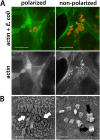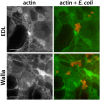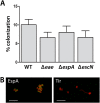Enterohemorrhagic Escherichia coli colonization of human colonic epithelium in vitro and ex vivo
- PMID: 25534942
- PMCID: PMC4333473
- DOI: 10.1128/IAI.02928-14
Enterohemorrhagic Escherichia coli colonization of human colonic epithelium in vitro and ex vivo
Abstract
Enterohemorrhagic Escherichia coli (EHEC) is an important foodborne pathogen causing gastroenteritis and more severe complications, such as hemorrhagic colitis and hemolytic uremic syndrome. Pathology is most pronounced in the colon, but to date there is no direct clinical evidence showing EHEC binding to the colonic epithelium in patients. In this study, we investigated EHEC adherence to the human colon by using in vitro organ culture (IVOC) of colonic biopsy samples and polarized T84 colon carcinoma cells. We show for the first time that EHEC colonizes human colonic biopsy samples by forming typical attaching and effacing (A/E) lesions which are dependent on EHEC type III secretion (T3S) and binding of the outer membrane protein intimin to the translocated intimin receptor (Tir). A/E lesion formation was dependent on oxygen levels and suppressed under oxygen-rich culture conditions routinely used for IVOC. In contrast, EHEC adherence to polarized T84 cells occurred independently of T3S and intimin and did not involve Tir translocation into the host cell membrane. Colonization of neither biopsy samples nor T84 cells was significantly affected by expression of Shiga toxins. Our study suggests that EHEC colonizes and forms stable A/E lesions on the human colon, which are likely to contribute to intestinal pathology during infection. Furthermore, care needs to be taken when using cell culture models, as they might not reflect the in vivo situation.
Copyright © 2015, Lewis et al.
Figures








References
Publication types
MeSH terms
Substances
Grants and funding
LinkOut - more resources
Full Text Sources
Other Literature Sources

